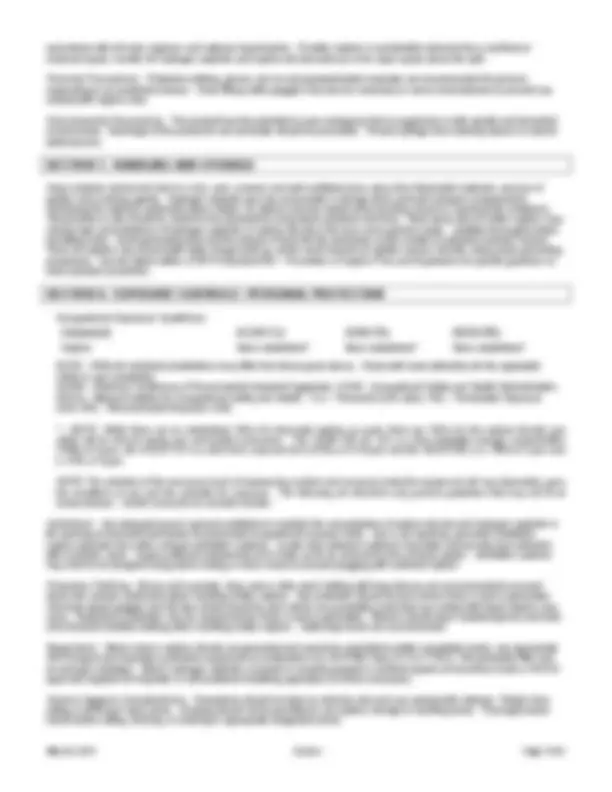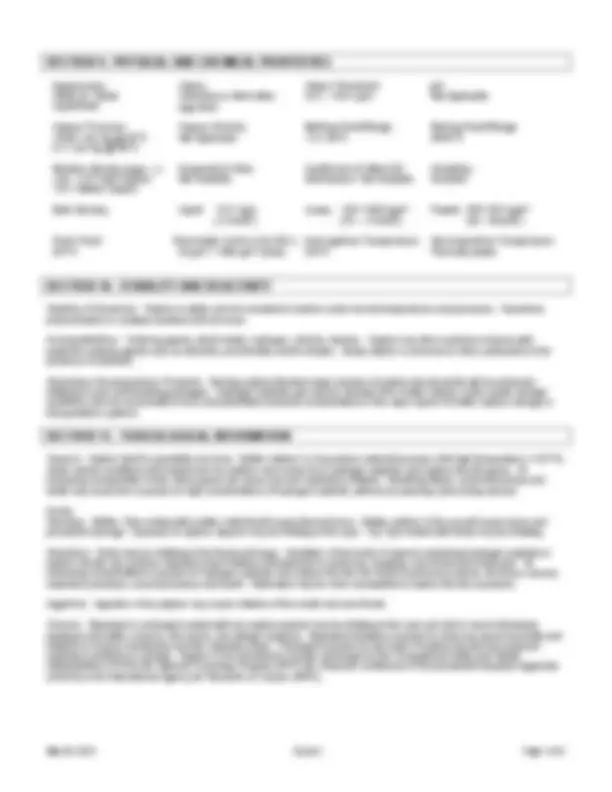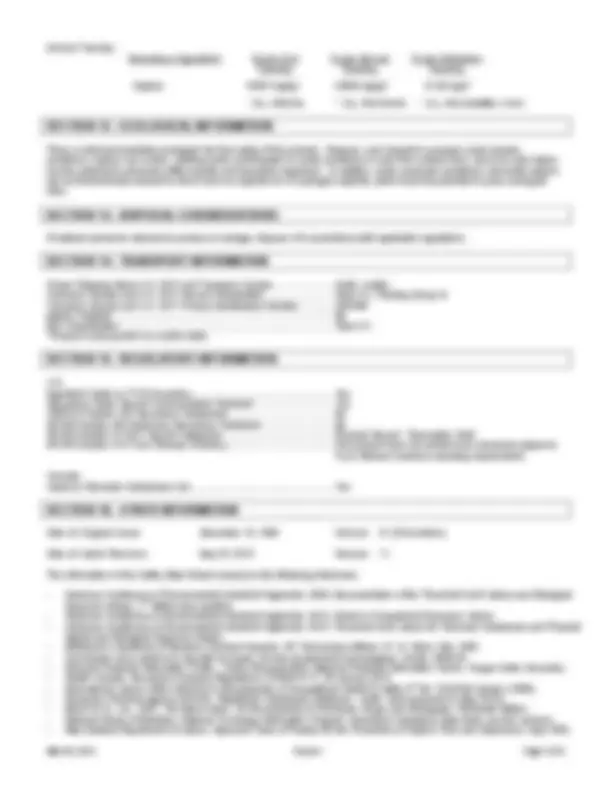





Study with the several resources on Docsity

Earn points by helping other students or get them with a premium plan


Prepare for your exams
Study with the several resources on Docsity

Earn points to download
Earn points by helping other students or get them with a premium plan
Community
Ask the community for help and clear up your study doubts
Discover the best universities in your country according to Docsity users
Free resources
Download our free guides on studying techniques, anxiety management strategies, and thesis advice from Docsity tutors
Safety information for handling, storing, and exposure controls to sulphur. It covers the hazards of both solid and molten sulphur, including combustibility, toxicity, and irritation. The document also outlines occupational exposure guidelines, protective measures, and emergency response procedures.
Typology: Study notes
1 / 6

This page cannot be seen from the preview
Don't miss anything!




Product Identity: Molten Sulphur. Trade Names and Synonyms: Sulfur, flowers of sulfur, brimstone. Manufacturer: Teck Metals Ltd. Trail Operations Trail, British Columbia V1R 4L Emergency Telephone: 250- 364 - 4214 Supplier: Teck Metals Ltd. Trail Operations Trail, British Columbia V1R 4L Preparer: Teck Metals Ltd. Suite 3300 – 550 Burrard Street Vancouver, British Columbia V6C 0B Date of Last Revision: May 25, 2015. Date of Last Edit: May 25, 2015. Product Use: Raw material used in the manufacture of sulphuric acid and sulphur dioxide. Note: Although this SDS was prepared to address the hazards of molten sulphur, Teck Metals Ltd. recognizes that the product transforms into a solid rapidly upon cooling. Sections 2 , 4, 5, 6, 7, 8, 9, and 11 address the hazards of the dry, as well as the molten, state of sulphur.
Health Physical Environmental Acute Toxicity (Oral, Inhalation) – Does not meet criteria Skin Corrosion/Irritation – Does not meet criteria Eye Damage/Eye Irritation – Does not meet criteria Respiratory or Skin Sensitization – Does not meet criteria Mutagenicity – Does not meet criteria Carcinogenicity – Does not meet criteria Reproductive Toxicity – Does not meet criteria Specific Target Organ Toxicity Acute Exposure – Does not meet criteria Chronic Exposure – Does not meet criteria Flammable Solids – Category 2 Combustible Dust – Category 1 Aquatic Toxicity – Short Term/Long Term Does not meet criteria LABEL: Symbols: Signal Word: WARNING Hazard Statements WARNING! Flammable Solid. May form combustible dust concentrations in air. Precautionary Statements: Keep away from heat, hot surfaces, sparks, open flames, and other ignition sources. No smoking. Ground and bond container and receiving equipment. Use explosion-proof equipment if dust cloud can occur. Wear protective gloves, clothing and eye protection (and face protection where appropriate). IN CASE OF FIRE: Use dry sand, etc. on small fires. Use water spray, fog or foam on larger fires. Emergency Overview: A bright yellow powder or an amber-to-yellow liquid. Sulphur is relatively non-toxic and poses little immediate health hazard to the environment or emergency response personnel unless it is involved in a fire. Both solid and liquid sulphur are combustible and generate large quantities of toxic and irritating sulphur dioxide gas on burning. Molten sulphur is hot enough to cause serious thermal burns to unprotected skin. Wear full protective clothing and positive pressure self-contained breathing apparatus in emergency situations involving burning sulphur.
Potential Health Effects: Sulphur is relatively non-toxic to humans, causing only mild local irritation to the eyes, nose, throat and upper airways. However, under certain circumstances it may release toxic hydrogen sulphide and/or sulphur dioxide gas. Sulphur is not listed as a carcinogen by OSHA, NTP, IARC or ACGIH (see Toxicological Information, Section 11). Potential Environmental Effects: This product has the potential to pose ecological risks to organisms in both aquatic and terrestrial environments. Discharge of the product to soil and water should be prevented (see Ecological Information, Section 12).
HAZARDOUS COMPONENTS CAS Registry No. CONCENTRATION (% wgt/wgt) Sulphur 7704 - 34 - 9 99.5% Note: See Section 8 for Occupational Exposure Guidelines.
Eye Contact: Symptoms: Mild eye irritation, redness: Do not allow victim to rub eye(s). Let the eye(s) water naturally for a few minutes. If particle/dust does not dislodge, flush with lukewarm, gently flowing water for 5 minutes or until particle/dust is removed, while holding eyelid(s) open. If irritation persists, obtain medical advice/attention. DO NOT attempt to manually remove anything stuck to the eye. Skin Contact: Symptoms: Mild irritation, dryness, thermal burn from molten sulphur. Dry sulphur : No health effects expected. If irritation does occur, flush with lukewarm, gently flowing water for 5 minutes. If irritation persists, obtain medical advice/attention. Molten sulphur: Flush contact area to solidify and cool but do not attempt to remove encrusted material or clothing. Cover burns and seek medical attention immediately. Inhalation: Symptoms: Coughing, irritation in heavy dust clouds. Remove source of contamination or move victim from exposure area to fresh air. Obtain medical advice/attention if you are concerned or feel unwell. Ingestion: Symptoms: Throat dryness, sulphur taste. If swallowed, no specific intervention is indicated as this material is not likely to be hazardous by ingestion. However, if irritation or discomfort occurs or you are concerned, obtain medical advice/attention.
Fire and Explosion Hazards: Both molten and solid forms are combustible and will ignite at high temperatures (> 200 °C), burning with a pale blue flame that may be difficult to see in daylight. Sulphur dust suspended in air ignites easily and can cause explosions in confined spaces. Sulphur dust clouds can be ignited by friction, static electricity, heat, sparks or flames. Traces of hydrogen sulphide and sulphur vapor may present an explosion hazard if evolved into a confined space or enclosed space, particularly from molten sulphur. The LEL of hydrogen sulphide (4.3% by volume in air) may be exceeded in enclosed spaces above molten sulphur. Extinguishing Media: Use water spray, fog or foam. Do not use direct water streams as the burning sulphur may float and further spread the fire. Sand, dry chemical or fine earth/finely crushed stone may be used for small fires. Steam or inert gases are excellent extinguishers for use in containers that can be tightly closed. Fire Fighting: Toxic fumes of sulphur dioxide will result from combustion. Fire fighters must be fully-trained and wear full protective clothing including an approved, self-contained breathing apparatus which supplies a positive air pressure within a full face-piece mask. Do not spray water directly into containers of molten sulphur due to the danger of boil over. Also avoid spraying direct streams of water that may scatter burning sulphur and spread the fire or create sulphur dust clouds and cause an explosion. Evacuate non-essential personnel from the fire area immediately. For large fires, consider evacuation of an area downwind of fire if necessary. Fire will rekindle until mass has been cooled to below approximately 150°C. Cool surrounding area and containers until well after the fire is out to prevent re-ignition.
Procedures for Cleanup: Control source of spillage if possible to do so safely. Contain spill, isolate area, and deny entry to unauthorized personnel. Remove all potential ignition sources. Ventilate area. Prevent spread of liquid by diking or ditching and allowing material to cool and solidify. Clean up spilled material immediately, observing precautions in Section 8, Personal Protection and using methods which will minimize dust generation (e.g., dampen material and shovel or wet sweep using natural fiber brooms and aluminum shovels to prevent sparks). Return uncontaminated spilled material to the process if possible. Place contaminated material in suitable labeled containers for later recovery or disposal. Treat or dispose of waste material in
Appearance: Amber to Yellow Liquid/Solid Odour: Odourless or faint rotten egg odour Odour Threshold: H 2 S – <0.01 ppm pH: Not Applicable Vapour Pressure: <0.001 mm Hg @ 20°C 0.11 mm Hg @140°C Vapour Density: Not Applicable Melting Point/Range: 112 - 120°C Boiling Point/Range: 444.6°C Relative Density (Water = 1) : 1.92 - 2.07 Solid Sulphur 1.811 Molten Sulphur Evaporation Rate: Not Available Coefficient of Water/Oil Distribution: Not Available Solubility: Insoluble Bulk Density: Liquid 1.811 kg/L (113 lb/ft^3 ) Lumps 1201 - 1842 kg/m^3 (75 – 115 lb/ft^3 ) Powder 528 - 1281 kg/m^3 (33 – 80 lb/ft^3 ) Flash Point: 207 °C Flammable Limits (LEL/UEL): 35 g/m^3 / 1400 g/m^3 (Dust) Auto-ignition Temperature: 232 °C Decomposition Temperature: Thermally stable
Stability & Reactivity: Sulphur is stable and not considered reactive under normal temperatures and pressures. Hazardous polymerization or runaway reactions will not occur. Incompatibilities: Oxidizing agents, alkali metals, hydrogen, chlorine, fluorine. Sulphur may form explosive mixtures with powerful oxidizing agents such as chlorates, perchlorates and/or nitrates. Damp sulphur is corrosive to steel, particularly in the presence of chlorides. Hazardous Decomposition Products: Burning sulphur liberates large volumes of sulphur dioxide which will be extremely irritating to eyes and breathing passages. Hydrogen sulphide gas may be released from molten sulphur under certain storage conditions and can accumulate to toxic and potentially explosive concentrations in the vapor space of molten sulphur storage or transportation systems.
General: Sulphur itself is essentially non-toxic. Molten sulphur is a hazardous material because of its high temperature (>122°C). Under certain conditions both heated and dry sulphur may evolve toxic hydrogen sulphide and sulphur dioxide gases. At increasing concentration levels, these gases can cause eye and respiratory irritation. Breathing failure, unconsciousness and death may result from exposure to high concentrations of hydrogen sulphide, without any warning odour being sensed. Acute: Skin/Eye: Molten: Skin contact with molten material will cause thermal burns. Molten sulphur in the eye will cause burns and permanent damage. Exposure to sulphur vapours may be irritating to the eyes. Dry: Eye contact with dusts may be irritating. Inhalation: Dusts may be irritating to the throat and lungs. Inhalation of low levels of vapours containing hydrogen sulphide or sulphur dioxide can produce respiratory tract irritation characterized by sneezing, coughing, sore throat and chest pain. At increasing concentrations exposure to hydrogen sulphide and sulphur dioxide can result in pulmonary edema, dizziness, nausea, respiratory paralysis, unconsciousness and death. Asthmatics may be more susceptible to sulphur dioxide exposures. Ingestion: Ingestion of dry sulphur may cause irritation of the mouth and sore throat. Chronic: Repeated or prolonged contact with dry sulphur powder may be irritating to the eyes and skin in some individuals, leading to dermatitis, eczema, skin ulcers, and allergic reactions. Repeated inhalation exposure to dust may cause bronchitis and irritation to mucous membranes and the respiratory tract. Prolonged exposure to low levels of sulphur dioxide has produced respiratory problems in animals. Sulphur is not considered a human carcinogen by the Occupational Safety and Health Administration (OSHA), the National Toxicology Program (NTP), the American Conference of Governmental Industrial Hygienists (ACGIH) or the International Agency for Research on Cancer (IARC).
Animal Toxicity: Hazardous Ingredient: Acute Oral Toxicity: Acute Dermal Toxicity: Acute Inhalation Toxicity: Sulphur >8437 mg/kg†^ >2000 mg/kg* >5.43 mg/L‡ † (^) LD 50 , Rat,Oral, * LD 50 , Rat, Dermal ‡ (^) LC 50 , Rat, Inhalation, 4 hour
There is minimal immediate ecological risk from spills of this product. However, over long-term exposure under aerobic conditions, sulphur can oxidize, yielding acidic runoff (water) or acidic conditions in soils; the oxidized form, due to its acid nature, has the potential to adversely affect aquatic and terrestrial organisms. In addition, under anaerobic conditions, elemental sulphur can be biochemically reduced to forms such as sulphide ion or hydrogen sulphide, which have the potential to pose ecological risks.
If material cannot be returned to process or salvage, dispose of in accordance with applicable regulations.
Proper Shipping Name U.S. DOT and Transport Canada ........................ Sulfur, molten Transport Canada and U.S. DOT Hazard Classification .......................... Class 4.1, Packing Group III Transport Canada and U.S. DOT Product Identification Number ............. UN Marine Pollutant ........................................................................................ No IMO Classification ..................................................................................... Class 4. __* Product is transported in a molten state.
Ingredient Listed on TSCA Inventory ........................................................ Yes Hazardous Under Hazard Communication Standard ............................... Yes CERCLA Section 103 Hazardous Substances ......................................... No EPCRA Section 302 Extremely Hazardous Substance ............................ No EPCRA Section 311/312 Hazard Categories ........................................... Physical Hazard - Flammable Solid EPCRA Section 313 Toxic Release Inventory: ......................................... This product does not contain toxic chemicals subject to Toxic Release Inventory reporting requirements. Canada: Listed on Domestic Substances List ......................................................... Yes
Date of Original Issue: December 18, 1998 Version: 01 (First edition) Date of Latest Revision: May 25, 2015 Version: 11 The information in this Safety Data Sheet is based on the following references: